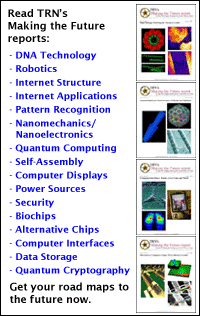
Single field shapes quantum
bits
By
Eric Smalley,
Technology Research NewsQuantum computers, which tap the properties of particles like atoms, photons and electrons to carry out computations, could potentially use a variety of schemes: individual photons controlled by optical networks, clouds of atoms linked by laser beams, and electrons trapped in quantum dots embedded in silicon chips.
Due to the strange nature of quantum particles, quantum computers are theoretically much faster than ordinary computers at solving certain large problems, like cracking secret codes.
Chip-based quantum computers would have a distinct advantage: the potential to leverage the extensive experience and manufacturing infrastructure of the semiconductor industry. Controlling individual electrons, however, is extremely challenging.
Researchers have recently realized that it may be possible to control the electrons in a quantum computer using a single magnetic field rather than having to produce extremely small, precisely focused magnetic fields for each electron.
Researchers from the University of Toronto and the University of Wisconsin at Madison have advanced this idea with a scheme that allows individual electrons to serve as the quantum bits that store and process computer information. The scheme is an improvement over existing global magnetic field schemes, which require each qubit to consist of two or more electrons.
Electrons have two magnetic orientations, spin up and spin down, which can represent the 1s and 0s of computing. The logic of quantum computing is based on one-qubit gates and two-qubit gates. One-qubit gates flip individual spins, changing a 1 to a 0 and vice versa. Two-qubit gates cause two spins to become linked, or entangled.
The researchers' scheme relies on the interactions of pairs of electrons to create both types of gates. Tiny electrodes positioned near quantum dots -- bits of semiconductor material that can trap single electrons -- can draw neighboring electrons near enough that they exchange energy. If the electrons interact long enough, they swap spin orientations. The challenge is finding a way to use the interaction to flip the spin of one electron without flipping the spin of the other.
The scheme does so by taking a pair of electrons through eleven incremental steps using the electron interaction and the global magnetic field. "We first turn on the exchange interactions... through small electrodes to generate a swap gate, then turn on the global magnetic field," said Lian-Ao Wu, a research associate at the University of Toronto.
The eleven steps -- four electron interactions and seven pulses of the magnetic field -- alter the spins. Because the magnetic field diminishes in strength over distance each electron is exposed to a different strength. By tuning the field, the researchers can make the process cancel out the changes to one spin while flipping the other, according to Wu.
The researchers' scheme could be implemented using a pair of square, 100-nanometer-diameter aluminum nanowires separated by a thin insulating layer. A row of quantum dots in a zigzag pattern would be positioned parallel to the wires, with half of the dots 200 nanometers from the wires and the other half 300 nanometers away. A nanometer is one millionth of a millimeter, or the span of 10 hydrogen atoms.
The ability to build such a quantum computer depends on developments in nanotechnology, said Wu. "It is still hard to design a complete control scheme of the exchange interactions," he said. "Once such obstacles are overcome, our scheme should offer significant simplifications and flexibility."
The on-chip conducting wires called for in the researchers' scheme have been used in physics experiments involving controlling beams of atoms and Bose-Einstein condensates, which are small clusters of atoms induced to behave as one quantum entity, according to Wu.
The researchers are working on reducing the number of steps required for their quantum logic circuit, combining their scheme with quantum error correction techniques, and reducing the engineering challenge of implementing the design, said Wu. The scheme would require making the aluminum wires with a precision of a single layer of atoms, but optimizing the scheme should make it possible to loosen the requirements to several atomic layers, which is technologically feasible, according to Wu.
"The main challenge is [achieving a] high degree of control of the exchange interactions," he said.
The technique could be used practically in 10 to 20 years, said Wu.
Wu's research colleague was Daniel A. Lidar at the University of Toronto and Mark Friesen at the University of Wisconsin at Madison. The work appeared in the July 15, 2004 issue of Physical Review Letters. The research was funded by the Defense Advanced Research Projects Agency (DARPA), the National Science Foundation (NSF), and the Army Research Office/Advanced Research and Development Activity (ARO/ARDA).
Timeline: 10-20 years
Funding: Government
TRN Categories: Quantum Computing and Communications
Story Type: News
Related Elements: Technical paper, "One-Spin Quantum Logic Gates from Exchange Interactions and a Global Magnetic Field," Physical Review Letters, July 15, 2004
Advertisements:
November 3/10, 2004
Page One
Ultrathin carbon speeds circuits
DNA machines take a walk
DNA in nanotubes sorts molecules
Single field shapes quantum bits
Briefs:
Nanotubes lengthen to centimeters
Coated nanotubes record light
Photonic crystal lasers juiced
Lasers move droplets
Molecules form nano containers
Square rings promise reliable MRAM
News:
Research News Roundup
Research Watch blog
Features:
View from the High Ground Q&A
How It Works
RSS Feeds:
News
Ad links:
Buy an ad link
| Advertisements:
|
 |
Ad links: Clear History
Buy an ad link
|
TRN
Newswire and Headline Feeds for Web sites
|
© Copyright Technology Research News, LLC 2000-2006. All rights reserved.